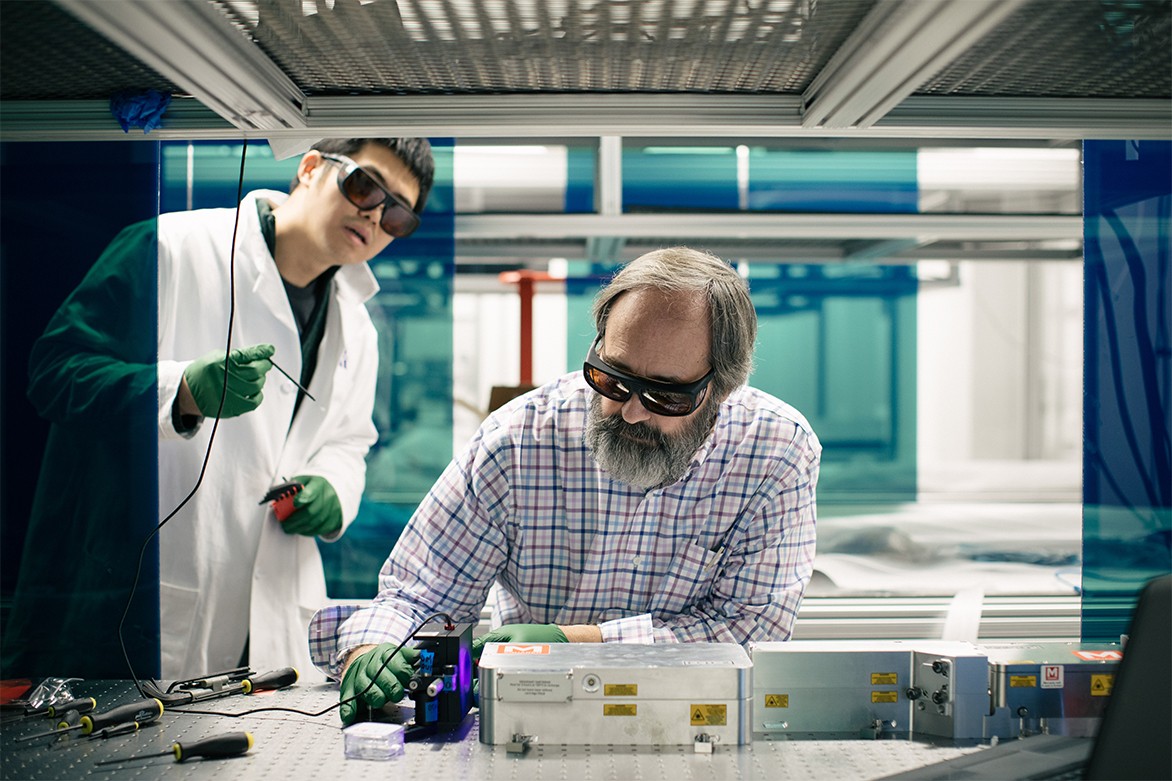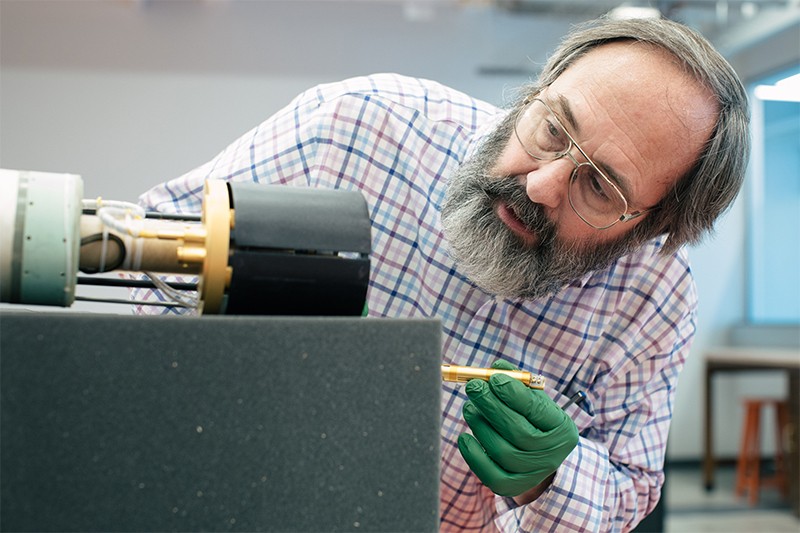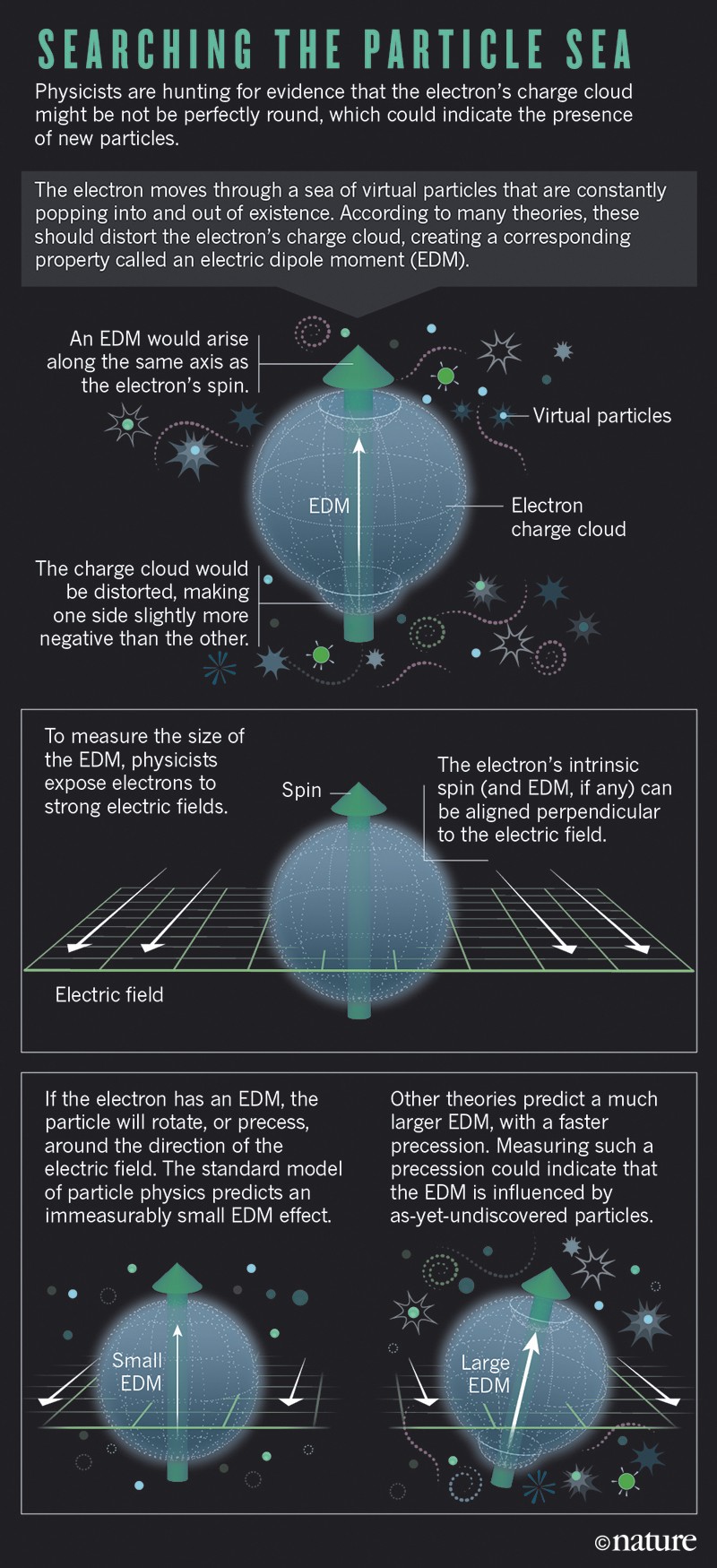10 January 2018
Gabriel Popkin
How tabletop experiments could find evidence of new particles, offering a glimpse beyond the standard model.

Gerald Gabrielse tunes a laser in his low-energy-physics lab at Northwestern University in Evanston, Illinois, with postdoc Wayne Huang. Credit: Alyssa Schukar for Nature.
It’s possible that no one knows the electron as well as physicist Gerald Gabrielse. He once held one in a trap for ten months to measure the size of its internal magnet. When it disappeared, he searched for two days before accepting that it was gone. “You get kind of fond of your particles after a while,” he says.
And Gabrielse has had ample time to become fond of the electron. For more than 30 years, he has been putting sophisticated electromagnetic traps and lasers to work to reveal the particle’s secrets, hoping to find the first hints of what’s beyond the standard model of particle physics — the field’s long-standing, but incomplete, foundational theory. Yet for many of those years, it seemed as if he was working in the shadow of high-energy facilities such as the Large Hadron Collider (LHC), the 27-kilometre-circumference, US$5-billion particle accelerator near Geneva, Switzerland. “There was a time in my career when there weren’t very many people doing this kind of thing, and I wondered if it was the right choice,” he says.
Now, he’s suddenly moving from the fringes of physics to the limelight. Northwestern University in Evanston, Illinois, is about to open a first-of-its-kind research institute dedicated to just his sort of small-scale particle physics, and Gabrielse will be its founding director.

The move signals a shift in the search for new physics. Researchers have dreamed of finding subatomic particles that could help them to solve some of the thorniest remaining problems in physics. But six years’ worth of LHC data have failed to produce a definitive detection of anything unexpected.
More physicists are moving in Gabrielse’s direction, with modest set-ups that can fit in standard university laboratories. Instead of brute-force methods such as smashing particles, these low-energy experimentalists use precision techniques to look for extraordinarily subtle deviations in some of nature’s most fundamental parameters. The slightest discrepancy could point the way to the field’s future.
Even researchers long associated with high-energy physics are starting to look to low-energy experiments for glimpses beyond the standard model. If such hints emerge, they could point the way to explaining the mysteries of dark matter and dark energy, which collectively constitute some 95% of the Universe. “This is sort of a tectonic shift in the way we think of doing physics,” says Savas Dimopoulos, a theorist at Stanford University in California.
Squashed sphere
In some ways, these small-scale experiments are a return to how particle physics was once done. Gabrielse drew particular inspiration from a 1956 experiment by physicist Chien-Shiung Wu. In a laboratory at what is now the US National Institute of Standards and Technology in Gaithersburg, Maryland, Wu found an asymmetrical spatial pattern in how radioactive cobalt-60 atoms emit electrons. The finding, along with theoretical work, confirmed that two particles discovered almost a decade before were actually one and the same. It also helped to solidify faith in the burgeoning theoretical framework for the Universe’s fundamental particles and most of its fundamental forces, which would soon evolve into the standard model.
But physics was already moving towards bigger and more-expensive experimental machinery. Buoyed by a flush of post-Second World War cash and prestige, and by predictions that new particles would emerge in high-energy collisions, physicists proposed increasingly powerful and expensive particle accelerators. And they got them: facilities sprung up at Stanford; at Fermilab near Batavia, Illinois; at CERN near Geneva; and elsewhere.



Quarks, muons, neutrinos and, finally, the Higgs boson were discovered. The standard model was complete.






And yet, as a description of the Universe, it is incomplete. The standard model doesn’t explain, for example, why antimatter and matter were not created in equal parts at the start of the Universe. If they had been, they would have annihilated each other, leaving behind a featureless void. The standard model also says nothing about dark matter, which seems to bind galaxies together, or about the dark energy that is pushing the Universe apart at an accelerating rate.
“I like to call the standard model the great triumph and the great frustration of modern physics,” says Gabrielse. On the one hand, he says, it lets physicists predict some quantities “to ridiculous accuracy. On the other hand, we have a hole we can drive the Universe through.”

Gerald Gabrielse prepares to replace a cryogenic SQUID — a superconducting quantum interference device — in his lab. Credit: Alyssa Schukar for Nature.
Gabrielse’s work trapping and probing particles at very low energies has taken him to a smaller facility at CERN, home of the LHC, to hunt for differences between matter and antimatter (see Nature 548, 20–23; 2017). He and his colleagues have produced the most precise measurement yet of a physical quantity — the size of the electron’s internal magnet, or spin [1].

A laboratory at CERN hosts the only usable source of antiprotons, the proton’s antimatter counterpart. Maximilien Brice/CERN

But one of his biggest focuses in the past decade has been pinning down the shape of the electron. Although it is usually seen as a simple point with negative charge, the electron could have hidden complexity. If certain symmetries of nature — rules that say the Universe behaves the same under various reversals — are violated, the electron’s charge won’t have a perfectly spherical distribution. Instead, virtual particles that constantly wink in and out of existence will skew the overall distribution of charge, squashing it slightly out of shape and giving it what physicists call an electric dipole moment, or EDM (see ‘Searching the particle sea’).

Credit: Nik Spencer/Nature
The standard model predicts a tiny squashing — so small, Gabrielse says, that “there’s essentially no hope to measure it in my lifetime”. But some theories posit as-yet-undetected particles that could make the electron’s EDM roughly one billion times larger. Many of those theories fall into a class called supersymmetry, an extension of the standard model that could explain why the Higgs boson’s mass is smaller than expected, and that could unify the electromagnetic, weak and strong forces in the early Universe.

It might also reveal the nature of dark matter.
Attempts to measure the electron’s EDM go back more than four decades. Physicists have taken advantage of the fact that an electron with an EDM can rotate, or precess, around an electric field, tracing out a loop. The stronger the electric field, the faster — and more easily detectable — the precession.
But complications abound. Experimentalists can’t work with solitary electrons, because a strong electric field would cause them to skitter away. Luckily, atoms and molecules effectively lock electrons in place — and can produce internal electric fields stronger than the strongest laboratory-made field. Because atoms and molecules absorb light at specific frequencies, researchers can use lasers to trap and cool them — and nudge their internal electrons into different configurations.
By the mid 2000s, several generations of experiments building on these techniques had ratcheted down the upper limit on the size of the electron’s EDM, but not quite to the level that would reveal the influence of particles predicted by supersymmetry or other extensions of the standard model. One of those experiments was conducted at Yale University in New Haven, Connecticut, by physicist David DeMille and his colleagues, using thallium ions [2]. But DeMille was running out of ideas for teasing more accuracy from his experiment, which was demanding an increasingly byzantine arrangement of highly calibrated lasers, vacuum chambers and cryogenics.
A breakthrough came in 2008, when two theorists at JILA, a research institute in Boulder, Colorado, reported [3] that the molecule thorium oxide had an internal electric field roughly 1,000 times the strength of thallium’s, which would make a precession effect in its electrons much easier to see. Around the same time, Gabrielse — who was then at Harvard University in Cambridge, Massachusetts — had wrapped up a long-running study and decided that he wanted to get into the electric-dipole game. He talked to John Doyle, also a physicist at Harvard, who had invented a new way to make focused beams of cold, slow-moving molecules. DeMille also contacted Doyle, and the three decided to join forces. In 2009, the trio’s experiment, called Advanced Cold Molecule Electron EDM, or ACME, received a 5-year, $6.2-million grant from the US National Science Foundation.
Precession procession
The group set up shop at Harvard. Gabrielse worked on making the team’s lasers — eight in total — more stable and accurate. Doyle focused on producing high-quality beams of thousands of thorium oxide molecules. And DeMille designed a system to align the molecules and shield them from outside interference.
In the experiment, a lab-made electric field orients the thorium oxide molecules. A pair of lasers then sets the spin direction of an electron inside each molecule to be perpendicular to the molecule’s internal electric field, and a magnetic field is used to make the particle’s spin precess. If the electron has an EDM, it will slightly add to or subtract from that rotation. After about one millisecond, polarized laser light bouncing off the molecules reveals how far their electrons have precessed. The experiment is then repeated with the molecules’ orientations reversed, which should reverse the direction of precession due to an EDM. The larger the difference in precession angle, the larger the EDM.
In early 2014, the researchers reported [4] that they had not seen evidence for an EDM in their set-up, which was sensitive to an angular difference of about 100-millionths of a degree. That drove the upper limit of the electron EDM down by more than a factor of 10, to 8.7 × 10^−29 in units of centimetres multiplied by electron charge. If an electron were the size of Earth — and Earth a perfect sphere — the limit would correspond to moving a patch of material roughly 20 nanometres thick from one pole to the other.

The ACME team argued that the result has big implications for theories beyond the standard model, nixing many hypothetical supersymmetric particles that would exist in an energy range probed by the LHC. But some theorists counter that plenty of remaining theories — supersymmetric and otherwise — predict an electron EDM smaller than those ruled out by the ACME team. Gabrielse finds the surviving theories more and more contrived. “Theorists are wily,” he says. “Every time we exclude something, they try to wiggle out.”
ACME is not alone in this effort. After earning a Nobel prize in 2001 for creating a new phase of matter called a Bose–Einstein condensate, JILA physicist Eric Cornell teamed up with Jun Ye, also at JILA, to look for an EDM. Rather than manipulate molecules as they pass by in a beam, as ACME does, Cornell and Ye decided to use a rotating electric field to trap molecular ions with large internal fields, giving electron precessions longer to reveal themselves. DeMille calls the idea “brilliant and far from obvious”.
Cornell faced a setback when he lost an arm to necrotizing fasciitis in 2004. But it led to a joke he likes to tell when he gives talks: “His left sleeve is empty, and he’ll say, ‘If anybody should know about asymmetry, it’s me’,” says former lab mate Chris Monroe, now a physicist at the University of Maryland in College Park. After a decade building and refining what Cornell calls a “two-tabletop experiment” (because it occupies two tables in his lab), he and his co-authors finally published their first results last year [5], coming within a factor of 1.5 of ACME’s 2014 limit. “I might not have started if I had realized how hard it would be,” says Cornell.
Now, researchers are closing in on new EDM results. The ACME physicists have increased the number of molecules they can send into their experimental apparatus by a factor of 400. They expect this and other improvements to sharpen the experiment’s precision by a factor of ten — allowing them to hunt for effects beyond the energy range of the LHC. The JILA team is also gearing up for experiments set to push beyond the LHC’s reach. And researchers at Imperial College London who held a former electron-EDM measurement record6 have plans for experiments with laser-cooled ytterbium monofluoride molecules; they hope their test will be 1,000 times more precise than ACME’s first run.
The electron isn’t the only low-energy peephole into the world beyond the standard model. Some physicists are searching for EDMs in neutrons or atoms, which, like the electron, could reveal a violation of one of nature’s symmetries. Others are adapting an entirely different technology in service of fundamental physics: atomic clocks. The frequencies of radiation absorbed and emitted by the atoms that make up these clocks depend only on certain fundamental constants of nature. A slight deviation in those frequencies could lend support to theories that attempt to explain why gravity is so much weaker than the Universe’s other forces.
The ability to test this idea was out of reach until the early 2000s, when researchers developed atomic clocks that operate in the optical range of the electromagnetic spectrum instead of in the microwave. Their higher frequencies meant that time could be sampled at a much higher rate, enabling the creation of clocks so precise that they would lose or gain less than one second over the age of the Universe. Researchers have since used data from such clocks to search for changes in the ratio between the electron’s and proton’s masses and in the fine-structure constant — a fundamental parameter that governs the strength of the electromagnetic force. Others, following a proposal [7] by Asimina Arvanitaki, a theorist at the Perimeter Institute for Theoretical Physics in Waterloo, Canada, are using clocks to look for subtle oscillations that might be created by a hypothesized dark-matter candidate called the axion, or a related particle.
So far, these investigations have yielded no new physics. But they show how a younger generation of physicists is infusing the field with new ideas, says Dimopoulos, who was Arvanitaki’s PhD adviser. “There’s a lot of theoretical ideas that have been, in a sense, overlooked because everybody was focusing on the LHC and the previous colliders,” he says.
No one expects such tabletop experiments to replace particle colliders. Rather, they could guide physicists to the right energy range for more detailed study. Right now, the collider community suspects that it needs more energy than the LHC is designed to reach, but it’s unclear how much will be sufficient. Findings from low-energy experiments might influence a multibillion-dollar decision about the next big collider, and that has put added pressure on researchers working in this tabletop realm. “We have to do almost everything with more care than is typical in the standard atomic-physics experiment,” says DeMille.
Gabrielse has high hopes for the team’s next experiment — and for the work at his centre at Northwestern, which is set to open this year. But he can make no promises. “We’re fishing for a fish whose shape and colour and speed and equipment for biting are completely unknown.”
See the full article here .
Please help promote STEM in your local schools.
Nature is a weekly international journal publishing the finest peer-reviewed research in all fields of science and technology on the basis of its originality, importance, interdisciplinary interest, timeliness, accessibility, elegance and surprising conclusions. Nature also provides rapid, authoritative, insightful and arresting news and interpretation of topical and coming trends affecting science, scientists and the wider public.
